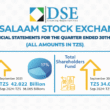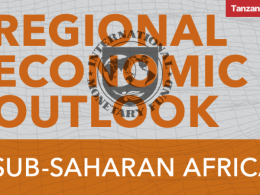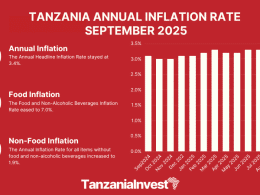The World Bank (WB) has recently released its 17th Tanzania Economic Update (TEU), a biannual report describing the recent evolution of Tanzania’s economy, and each edition highlights a subject of critical interest to policymakers.
In this latest report, high-frequency data suggest that economic activity is gradually recovering from the impact of the Covid-19 pandemic.
The accommodation and restaurants, mining, and electricity sectors drove a sharp rebound during Q3 2021.
Leading indicators such as cement production, electricity generation, private-sector credit, goods and services exports, nonfuel goods imports, telecommunications, mobility, and tourist arrivals all improved in 2021, though activity in most sectors remains below pre-pandemic levels.
Nevertheless, the preliminary findings from a recent survey suggest that employment among heads of household returned to its January 2020 level in mid-2021.
As a result, the WB estimates a real GDP growth rate of 4.3% and a GDP per capita growth rate of 1.3% in 2021, following a 1.0% per capita GDP contraction in 2020.
Meanwhile, the national poverty rate is estimated to have declined marginally from 27.1% in 2020 to 27.0% in 2021, driven by the recovery of employment and nonfarm business revenue.
Although exports have increased, Tanzania’s current-account deficit has widened slightly. The current-account deficit reached 2.0% of GDP at end-September 2021, as import growth more than offset export growth.
Services and manufacturing exports to East African Community (EAC) member states significantly increased due to improving relations between Tanzania and its neighbors, but the implementation of capital projects spurred a sharp rise in imports of oil and capital goods.
The current-account deficit was funded largely by external loans and foreign direct investment.
The Tanzanian shilling (TZS) remained relatively stable against the currencies of major trading partners in 2021.
Gross official reserves increased to about USD 6.7 billion by the end-October 2021 (equal to about seven months of imports of goods and services) thanks to the disbursement of a USD 751 million IMF Rapid Credit Facility.
The authorities have continued to implement an expansionary monetary policy, but the growth rate of credit to the private sector remained relatively low at 5.6% in October 2021, while lending rates remained stubbornly high at about 17%.
The banking sector is relatively stable, and the nonperforming loan ratio fell to 8.0% in October 2021, though it remains above the central bank’s national prudential threshold of 5.0%.
Tanzania’s inflation rate rose to 4.1% in November 2021, its highest level in the past three years, but it remains among the lowest and least volatile in the EAC.
Significant revenue shortfalls widened the fiscal deficit, leading to increased domestic borrowing in 2020/21. The fiscal deficit expanded to 4.2% of GDP in 2020/21, more than double the 1.4% observed in 2019/20 and significantly above the 2.7% target for 2020/21.
As for the Debt Sustainability Analysis, the WB concluded that Tanzania’s risk of external debt distress had increased from low to moderate. The downgrade primarily reflected the collapse of tourism exports during the Covid-19 pandemic in a context of increased non-concessional borrowing and rising debt service.
Tanzania GDP Growth in 2022 and Beyond
The WB expects Tanzania’s economic growth to strengthen over the next two years (2022 and 2023), assuming pandemic conditions ease and the external environment improves. The real GDP growth rate is projected to reach 4.5–5.5% in 2022 and to average 6% over the medium term as exports and domestic demand recover.
After contracting in 2020 and rebounding in 2021, GDP per capita is expected to continue expanding in 2022.
Nonetheless, Tanzania’s vulnerability to the global pandemic remains high amid the slow vaccination rollout. The evolution of the pandemic and the pace of vaccination, both globally and domestically, will be the most crucial factors driving Tanzania’s outlook.
The government will need to strengthen its pandemic response in the short term while laying the groundwork for a private-sector-led recovery over the medium-to-long term.
The current-account deficit is projected to widen to 3.7% of GDP in 2022 due to rising imports, which will more than offset an expected increase in exports.
The fiscal deficit is projected to widen to 4.2% of GDP in 2022, driven by pandemic-related public spending and the implementation of several major capital projects.
The national poverty rate is expected to decline to 26.7% in 2022 and reach 26.4% in 2023, supported by the growth of high-quality nonfarm employment, including among women.










